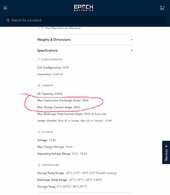1. From what I know it sounds like 60 Amps is the max most vehicle alternators can distribute so I was thinking a 50 amp DC to DC charger would be good.
2. yes, drone batt charger draw is 1100 watts at 120v AC
3. from another post this looks right, 10x6Ah batteries at 53v, that's ~3200 watt hours, times 1.25 for conversion inefficiency. ~4000 watt hours. my work schedule with the drone is normally 1.5 Hours vehicle off .5 drive to next location 1.5 off on average however if the drive time is shortened I could just idle the vehicle if need be but not ideal. my thoughts right now are something between 12v 200ah-400ah and would like heating for the cold days, your recommendation looks good.
So let’s look at it

;
#3) 4000Whr including inverter efficiency is your daily energy need

#2) 1100W / say 80% efficiency would give you a 1375W power ,,, so a 2000W inverter should be plenty ,,, thus for easy math drop a zero & you can expect your typical current from a 12vdc battery to be less than 200 amps.
#1) So this is where you issue will be. The only source that you can get this spec/info from is the vehicle manufacturer. Alternators & available power to charge your system depends upon many variable; temperature, rpm, other vehicle needs ( like charging the starter battery or HVAC or etc ). I have a Promaster van with a 220A alternator & the “van” can use more than 180A itself under the right conditions. It is important for you to “figure this out to the best of your ability”. You could consider a 2nd alternator just to charge your DIY system.
So if You DIY or buy an AIO unit really comes down to #1 & the “available power” that can go to the DIY system.
Now that being said, AIO are getting better, but you would need to look at the specs & understand their operations & limitations. If you have a particular Make / Model in mind you can post it here & it can be reviewed in light of your application. Pros & Cons to all decision.
Some of the Cons to AIO in the past;
1) Very slow alternator charging capability ( anything off a cigarette lighter / power plug by definition is dismal ). Some new AIO are better now, but depends upon which model
2) Self energy consuming ,,, idle energy use ,,, might not matter if the unit is turned off, but this spec & how a unit functions really matters in the equasion.
3) Upgrade or serviceability
If you do not have the “alternator power” available to recharge a DIY or AIO for the timeframe of your driving, then you will need grid power 120vac or solar ( & the Sun’s cooperation ), or a generator.
Aquire the “specs” of your vehicle & alternator, but if it is a 60 amp alternator I am not sure what the auxiliary power would be ,,, but I highly doubt 50 amps ,,, I’m guessing more like 10A, 20A, maybe 30A if the vehicle loads are light.
So 140W / 280W / 420W ,,, & You need 4000Whrs

,,, Back to the drawing board.
Even @ 50A @ 14V = 700W you would need to drive about 6 hours to replenish 4000Whrs
Unless I misunderstood your scenario, I highly doubt you will achieve alternator charging 4000Whrs ,,, DIY system or AIO and shore power / grid ( or generator ).
Not that Drone Batteries are inexpensive ,,,
but another way of looking at it is just double your drone battery quantity ( & chargers ) & go to the field work with more drone batteries. I don’t totally understand your scenario, but more Drone Batteries might be your solution

? When looking at the economics of this (
all batteries ), like tires on a car
are a consumable. More drone batteries you have cuts out the middleman or in this case the middle electrical equipment. If you are a commercial operator, time is money & more drone batteries = less waiting to charge, less down time, more redundancy, more grid charging where you are way less limited. I am guessing plugged into a grid 120vac, you have your 4000Whrs charged up in about 4hrs. Double your drone batteries / charger then you have 8000Whrs in 4hrs @ your hotel room.
Again; I do not fully understand your needs, but you are considering a DIY or AIO & alternator to charge drone batteries by having LFP batteries. Maybe just double your drone batteries

?
OR;
Buy what you need for field capacity in LFP batteries & assume recharging them by EV Plug In & Grid, if that is available. At that point, I’m guessing you are looking at 48v battery bank ( maybe 24v ), and an ( Inverter / Charger ) unit ,,,
and any alternator / solar input is going to be a drop in the bucket assistance to you.




